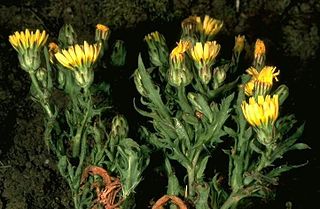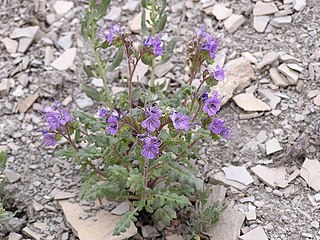
Arctostaphylos catalinae, known by the common name Santa Catalina Island manzanita, is a species of manzanita native to Southern California. The evergreen shrub is found growing naturally only on Catalina and Santa Cruz Islands on the coast ridges. It thrives in maritime chaparral and can be used in coastal gardens.
Melicope balloui, also called Ballou's melicope or rock pelea, is a species of plant in the family Rutaceae. It is endemic to the Hawaiian Islands. It is threatened by habitat loss. Like other Hawaiian Melicope, this species is known as alani.

Dudleya candelabrum is a species of succulent plant known by the common names candleholder liveforever or candleholder dudleya. Endemic to California, this species grows wild only on the northern Channel Islands, where it is found in open rocky places and north-facing slopes. It is characterized by thin, spade-shaped green leaves and an inflorescence covered in long, reflexed bracts, with pale yellow flowers. It has been threatened by poachers shipping plants to South Korea.

Eriogonum arborescens is a species of wild buckwheat known by the common name Santa Cruz Island buckwheat.
Erysimum teretifolium is a species of Erysimum known by the common names Santa Cruz wallflower and Ben Lomond wallflower. It is a very rare plant endemic to Santa Cruz County, California, where it grows on inland sand spits, chaparral, and sandstone deposits in the southern Santa Cruz Mountains. It is a California state and federally listed endangered species.

Juncus capitatus is a species of rush known by the common names dwarf rush and leafybract dwarf rush. It is native to Europe, Asia and North Africa. It is also an introduced species in parts of North America such as California and the Gulf Coast. It grows in moist areas, such as wet sand, vernal pools, and ditches.

Dudleya greenei is a perennial species of succulent plant known by the common names Greene's liveforever, or Greene's dudleya. It is endemic to the Channel Islands of California, where it grows along the cliffs of four of the eight islands. It is a highly variable plant, presenting with multiple forms and varying levels of ploidy. Taxonomically, this species is an insular segregate of Dudleya caespitosa, and was placed as a stopgap taxon by Reid Moran in his 1951 thesis on the genus. It is characterized by white or green leaf rosettes, loomed over by inflorescences bearing pale yellow to white flowers. It is a member of the subgenus Dudleya, as it cannot be propagated from leaf cuttings, does not grow from a corm, and has tight petals.

Arctostaphylos montaraensis, known by the common name Montara manzanita, is a species of manzanita in the family Ericaceae.

Arctostaphylos pajaroensis is a species of manzanita known by the common name Pajaro manzanita. It is endemic to California, where it is known mainly from Monterey County.

Zeltnera davyi is a species of flowering plant in the gentian family known by the common name Davy's centaury.
Chorizanthe wheeleri is a rare species of flowering plant in the buckwheat family known by the common names Santa Barbara spineflower and Wheeler's spineflower. It is endemic to Santa Cruz and Santa Rosa Islands, two of the Channel Islands of California.
Malacothrix indecora is a rare species of flowering plant in the family Asteraceae known by the common name Santa Cruz Island desertdandelion. It is endemic to the Channel Islands of California, where it is known from only a few populations on three of the eight islands. As of 2000, there were three occurrences on San Miguel Island, two on Santa Rosa Island, and one on Santa Cruz Island. It grows on the bluffs and rocky coastal grasslands of the islands. Like many Channel Islands endemics, this plant is naturally limited in distribution and has been threatened by the presence of destructive introduced mammals, in this case, feral pigs. The plant became a federally listed endangered species in 1997. This is a mat-forming annual herb which spreads low to the ground no more than about 10 centimeters high. The fleshy leaves have dull lobes. The inflorescence is an array of flower heads lined with oval-shaped phyllaries. The ray florets are under a centimeter long and yellow in color.

Malacothrix squalida is a rare species of flowering plant in the family Asteraceae known by the common name Santa Cruz desertdandelion. It is endemic to Santa Cruz and Anacapa Islands, two of the eight Channel Islands of California, where it grows on rocky seaside bluffs and cliffs. The plant is very limited in distribution and today exists only in degraded habitat on these two small islands. It was last collected from Santa Cruz Island in 1968, and two populations were noted on Anacapa Island in 1998; in drought years there may be no plants at all. It became a federally listed endangered species in 1997. This is an annual herb growing a hairless, waxy stem 20 to 30 centimeters in maximum height. The leaves are sharply lobed. The inflorescence is an array of flower heads lined with oval-shaped phyllaries. The ray florets are 1 to 2 centimeters and light yellow in color.

Ribes thacherianum, with the common name Santa Cruz gooseberry, or Santa Cruz Island gooseberry, is a rare North American species of currant found only on the island of Santa Cruz off the coast of California.

Thysanocarpus conchuliferus is a rare species of flowering plant in the mustard family known by the common name Santa Cruz Island fringepod. It is endemic to Santa Cruz Island, one of the Channel Islands of California, where has been recently observed at only one location; some years it is totally absent.
Trifolium buckwestiorum is a rare species of clover known by the common name Santa Cruz clover.
Juncus digitatus is a rare species of rush known by the common name finger rush. It is endemic to Shasta County, California, where it is known from only two occurrences near Shingletown. It occurs in spring-moist habitat such as vernal pools in sunny locations in the foothills of the southernmost Cascade Range. The plant was first collected in 1991 and described to science as a new species in 2008.

Phacelia argillacea is a rare species of flowering plant in the borage family known by the common names clay phacelia and Atwood's phacelia. It is endemic to Utah in the United States, where it is known only from one canyon in Utah County. It is "one of Utah's most endangered species"; it is "one of the nation's rarest plants" and is federally listed as an endangered species of the United States.

Sanicula mariversa is a rare species of flowering plant in the family Apiaceae known by the common name Waianae Range black-snakeroot. It is endemic to Hawaii, where it is known only from the Waianae Mountains on the island of Oahu. It is threatened by the degradation of its habitat. It is a federally listed endangered species of the United States.

Vicia menziesii is a rare species of flowering plant in the legume family known by the common name Hawaiian vetch. It is endemic to Hawaii, where it is known only from the island of Hawaii. It is threatened by habitat loss and exotic plants. It has been federally listed as an endangered species of the United States since 1978. It was the first Hawaiian plant to be placed on the Endangered Species List.















